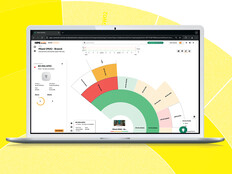6 Backbone Technologies that Power Healthcare
Healthcare organizations have been focused on rolling out key technology and process changes, mostly driven by the federal government’s electronic health record and meaningful use requirements. Now that EHR systems are largely in place, health systems can focus on optimizing that infrastructure as they gear up for the third round of MU requirements.
Fortunately, today’s technology is capable of easily handling clinical workloads. Cloud solutions have grown to include additional security and compliance capabilities. Service-level agreements, mobile Backend as a Service and other solutions are now tailored specifically to healthcare provider environments. Enterprise flash is proving itself in clinical applications and delivering superior performance. Converged infrastructure has become a standard for simplifying operations for the modern data center.
The next stage is leveraging those modern technologies to create agile IT departments that can scale rapidly to meet data and infrastructure demands across the continuum of care. With planning, healthcare organizations of all sizes and budgets will be better able to identify areas of opportunity and invest in the appropriate technology.
Understanding The Infrastructure Imperative
Networking, storage and security technology all play a critical role in the success and ongoing viability of any patient-centered technology rollout. This back-end infrastructure is the backbone of patient-centered technology initiatives.
To achieve the levels of scalability, reliability and support required today and in the future, it may be necessary to invest in upgrades or replacements in the existing infrastructure, especially legacy systems.
The data center is the heart of a hospital operation. The network is the circulatory system, moving data both from and to the data center.
There are six main technologies in the data center that require attention when planning an upgrade or build:
1. Storage Management and Virtualization
Data storage needs are growing at unprecedented and unrelenting rates. EHR is driving a lot of this storage need but so is the increasing use of rich media images and video applications in patient files. Storage management and virtualization enable smarter leveraging of server environments for maximum efficiency, security and storage capacity.
2. Server Virtualization
Server virtualization and clustering solutions make it possible to run multiple applications and operating systems independently on a single server. These technologies also enable the integration of disparate storage systems and the ability to enhance business continuity.
3. Client Virtualization
Virtualizing end-user desktops affords IT the best and most efficient means of managing desktops and also enables users to access their virtual desktops from practically any device, thereby enabling work from anywhere while also making the desktop vastly more secure.
4. Backup and Business Continuity
Backing up all applications and data is essential to ensure the organization can continue to operate during (and recover from) any disaster, ranging from the physical, such as a hurricane, to the virtual, such as a ransomware attack.
5. Power and Cooling Systems
These systems are of greater significance today because compact, higher density server technologies consume more power, generate more heat and require more cooling. Additionally, power waste adds to a hospital’s operating costs. Improving efficiencies in this area can save a hospital thousands of dollars each year.
6. The Network
Networks today require greater capacity, speed and reliability built in. Given EHR demands, patient expectations, and the pressures of multiple applications and devices, network traffic continues to climb. Lives depend on clinicians’ ability to access critical patient data. Protecting the network’s integrity, reliability, resiliency and security is essential. So is optimizing its performance and increasing bandwidth. Fortunately, newer technologies can provide for all of these needs and offer additional features too.
Prioritizing Network and Data Security in Healthcare
Protecting patients and facilities from data breaches and hacker attacks is a critical concern for healthcare organizations. Compliance issues also figure heavily in data security risks, because something as simple as a health worker having access to too much patient information can result in a violation of the Health Insurance Portability and Accountability Act. IT must walk a thin line to ensure information is available only to appropriate users and to protect information from malevolent attacks inside and outside of the organization.
A comprehensive network and data security platform will provide a range of solutions, including authentication, data loss prevention, mobile security, physical security and threat prevention.
Fortunately, new hardware and software can automate many security processes and even augment staff expertise on trickier detection and response calls. Security software can protect patient data and communications outside the hospital too.
Download the free white paper, "Healthcare Technology and the Patient Journey" to learn more.









